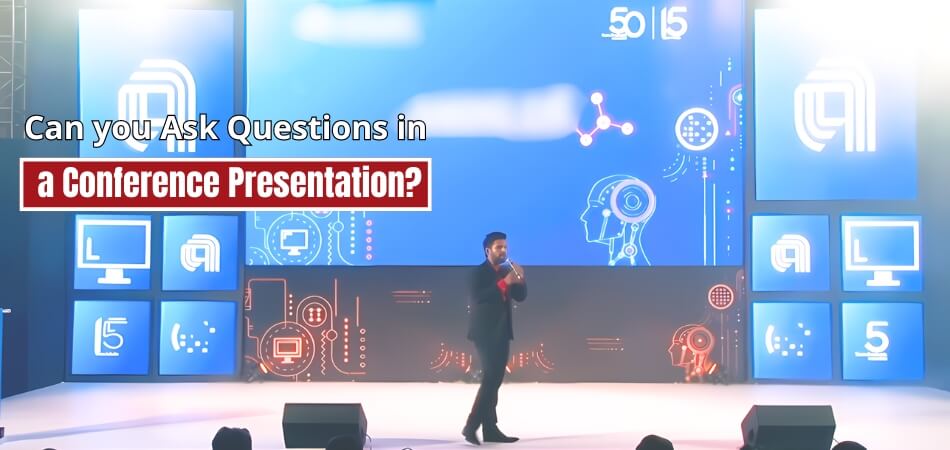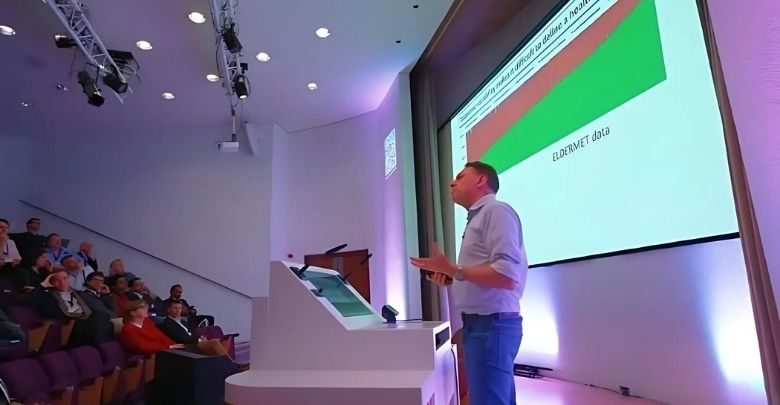When preparing for a conference presentation, careful planning and thoughtful content development are crucial. Knowing how to engage your audience effectively is a vital aspect of delivering a successful talk. As you consider various strategies, you might be wondering, Can you ask questions in a conference presentation?
Yes, you can certainly ask questions during a conference presentation. Questions serve as an effective way to engage the audience, stimulate discussion, and invite participation. When strategically placed, they can enhance communication and create a more interactive atmosphere. This approach encourages attendees to reflect on the content and share their insights, increasing the overall experience for everyone involved.
Are you curious about how to maximize audience engagement through questions? This article will dive into effective strategies and provide essential information on using questions in your presentations. By reading further, you’ll discover tips that will help you connect with your audience meaningfully.
Does Asking Questions Increase Audience Engagement?
Asking questions can boost audience engagement by sparking curiosity and encouraging involvement. When you ask questions, it invites readers to pause, reflect, and consider their views on the topic. This moment of reflection often leads to increased interest and interaction with the content. By engaging directly with the audience, you make them feel involved and valued, which fosters a stronger connection.
Moreover, questions help in creating an interactive atmosphere, making readers more likely to engage by liking, commenting, or sharing. It keeps them active as they explore the topic further, considering different perspectives and adding their thoughts. Asking questions also encourages a dialogue, where audiences feel they have a voice and can participate in shaping the conversation, thus boosting loyalty.
An ideal way to learn more about creating engaging discussions is by participating in a reliable conference with skilled speakers who know how to hold attention. These events teach valuable methods to attract audiences and sustain their interest through interactive techniques. By implementing these tactics, you can see a noticeable boost in how audiences engage with your content, making them more likely to stay connected.
Can You Ask Questions in a Conference Presentation?
Yes, you can ask questions in a conference presentation. Engaging your audience during a conference presentation can be challenging, but questions are an essential tool for creating impactful communication. Their use requires strategic placement and careful thought to effectively enhance audience connection.
Start Strong with Engaging Context
To capture audience interest right from the start, introduce context that resonates with the listeners’ experiences or knowledge. By creating relatable examples or sharing an insightful comment, you can set the foundation for their engagement. This approach encourages an active listening mindset, allowing the audience to become more involved as the presentation unfolds.
Maintain a Balance Between Questions and Content
Effective presentations use questions without confusing the audience. Making a balance between delivering substantial content and addressing audience queries is crucial. By anticipating questions and smoothly integrating them into your presentation, you can maintain audience focus and interest throughout. This technique ensures that the conversation remains fluid and engaging without causing confusion.
Guide with Visual Elements
Visual elements are useful tools for supporting your audience’s understanding of complex topics. Instead of directly asking questions, you can incorporate images, charts, or diagrams that spark curiosity and encourage reflection. These visual elements serve to clarify your message and enhance engagement, alleviating pressure on the audience while maintaining their interest throughout the presentation.
Focus on Audience Engagement Through Activities
Incorporating interactive activities can subtly encourage audience participation without direct questioning. Activities such as short discussions, think-pair-share exercises, or collaborative tasks allow participants to think critically about the material.
By facilitating a dynamic environment where attendees can share ideas, you improve involvement and interest, ensuring continuous engagement during your presentation.
Use Storytelling to Foster Connection
One effective way to engage your audience in your presentation is through storytelling. By sharing relevant anecdotes or experiences, you can establish an emotional link between the content and your audience. This narrative approach can implicitly pose questions for listeners to ponder, keeping the conversation flowing naturally while enhancing their connection to the topic.
Smoothly Incorporate Feedback Points
Creating natural points for audience feedback throughout your presentation is essential. Encouraging non-verbal reactions such as nodding or using interactive digital tools like polls can help you gather valuable input. These elements not only provide insight into whether your message resonates, but they also provide a sense of community, making attendees feel involved in the discussion.
Provide a Clear Summary for Deeper Knowledge
Summarizing your key points at the end of your presentation ensures that your audience leaves with a clear understanding of the core message. During this recap, you can weave in references that address commonly asked questions related to your topic. This approach empowers your audience and prepares them for further exploration, reinforcing their learning experience.
Careful use of these techniques enhances the effectiveness of your conference presentation. It keeps the audience engaged, makes your message clearer, and promotes active listening. By preparing for conference presentation questions and incorporating strategies like these, you can ensure a meaningful and impactful experience, ultimately equipping yourself to achieve your goals.
When Should You Introduce Questions in a Presentation?
Delivering a memorable presentation requires carefully timed questions to increase interest and deepen knowledge. Well-placed questions engage your audience and improve interaction, creating a meaningful experience. Here are some points on when to ask questions to get the most impact.
Begin with an Ice-Breaker Question
Starting with an ice-breaker question helps create a friendly atmosphere. This initial question doesn’t need to be complex; it should help the audience feel comfortable and willing to engage. Consider a lighthearted topic or a simple, open-ended question to set the tone. This can ease tension and make listeners feel included from the beginning.
Engage Midway with an Interesting Question
Include an interesting question in the middle of the speech. This strategy grabs attention and reinforces essential points. Presenting a thought-provoking question mid-presentation also helps reset any waning interest, bringing focus back to your topic. It gives your audience a chance to reflect on what they’ve learned so far, keeping them actively involved.
Use Questions to Transition Between Topics
Smooth transitions between topics can be achieved by asking questions. These questions guide your audience from one concept to the next, allowing them to connect ideas. A well-timed question also signals that a new section is beginning, which can help listeners follow the presentation’s flow better. It clarifies the narrative, making it easier to absorb new information.
Summarize Points with Audience Participation
Invite the audience to recap by answering summary questions. Questions that encourage participation help reinforce key takeaways, creating a lasting impression. Asking listeners to summarize can boost their confidence and show they understand the material. This interaction also offers valuable feedback, letting you gauge their grasp of your message.
Conclude with a Forward-Looking Question
Asking a closing question that inspires future planning helps the audience consider the topic’s applicability. This final question should inspire curiosity and spark interest in exploring more. It helps listeners connect the information to their lives, leaving them with a thought-provoking closure. This approach gives a sense of purpose beyond the presentation.
Using questions strategically throughout your presentation not only engages your audience but also creates a dynamic environment. This interaction promotes deeper knowledge, encourages participation, and improves the overall effectiveness of your message for lasting impact.
Which Types of Questions You Can Ask Your Audience at a Conference Presentation?
Engaging your audience during a conference presentation involves asking the right types of questions to stimulate thought and participation. Knowing which questions to ask can enhance interaction and make your presentation more memorable.
Opening Questions to Capture Attention
Starting with an engaging question can grab the audience’s attention immediately. This approach sets a positive tone for the presentation and piques curiosity about the subject. A well-chosen opening question helps relate the topic to the audience’s experiences, making the content more relevant and appealing right from the beginning.
Suggestive Questions to Encourage Thinking
Asking insightful questions successfully encourages the audience to consider the topic more thoroughly. While they don’t require an actual response, they stimulate internal reflection. Such questions highlight important points and encourage listeners to consider various perspectives, increasing their understanding without putting anyone on the spot.
Interactive Questions for Audience Participation
Asking interactive questions encourages active participation from the audience. These questions, whether requesting a show of hands or brief verbal responses, are adaptable across different types of conference presentations. Interactive questions help create a lively atmosphere, breaking down barriers between the speaker and the audience, while boosting engagement.
Polling Questions to Gauge Opinions
You can find out what the audience thinks or already knows about a subject by asking polling questions. Conducting polls through technology like clickers or apps or simply asking for a show of hands can be effective. Polling actively engages the audience while providing valuable insights that can shape the presentation’s direction.
Closing Questions to Prompt Reflection
Ending the presentation with a thoughtful question leaves a lasting impression on the audience. Such questions encourage them to reflect on what they have learned and how it applies to their lives. A closing question can inspire further discussion, fostering ongoing engagement even after the presentation concludes.
By carefully selecting the types of questions you ask during your conference presentation, you can create a more interactive and memorable experience for your audience and increase their understanding and enjoyment of your topic.
What to Do if Your Audience Isn’t Responding to Your Questions?
When you ask questions during a presentation, audience engagement is crucial. Sometimes, despite your best efforts, the audience may not respond as you hoped. Knowing how to handle this situation can greatly increase your presentation’s effectiveness.
- Use Open-Ended Questions: Encouraging more thoughtful responses can stimulate participation. Open-ended questions allow the audience to share their thoughts and experiences freely. This approach often leads to richer conversations and deeper engagement with your topic.
- Change Your Delivery Style: Adjusting your tone or pace can help grab attention. If the audience seems disengaged, try using a more dynamic and animated delivery. This change can rejuvenate the atmosphere and encourage people to respond more actively.
- Incorporate Visual Elements: Using visual elements can capture attention and prompt responses. Images, videos, or infographics can make your content more engaging. They serve as conversation starters and can lead to more questions from the audience.
- Create Interactive Activities: Engaging the audience with interactive activities can stimulate responses. Consider using quick polls, group discussions, or hands-on demonstrations. These activities foster collaboration and encourage audience members to participate more actively.
- Pause for Reflection: Taking a moment to pause after asking a question allows time for thinking. This brief silence can encourage audience members to gather their thoughts and respond. It gives them a chance to consider their answers more deeply.
- Address Different Learning Styles: Recognizing that everyone learns differently is vital. Tailor your questions to cater to various learning styles by incorporating verbal, visual, and kinesthetic elements. This approach can help you reach a broader audience and encourage more responses.
- Follow Up Personally: If the audience is hesitant to respond, consider following up with individuals later. Engaging in one-on-one conversations can create a more comfortable environment for sharing thoughts. This personal touch can lead to more meaningful interactions.
Handling an unresponsive audience requires adaptability and creativity. By using these strategies, you can foster engagement and create a more dynamic atmosphere. Ultimately, these efforts contribute to a more impactful and memorable presentation experience for everyone involved.
Frequently Asked Questions (FAQs)
Asking questions during a conference presentation can be a powerful tool to boost engagement and make your talk more interactive. Below are some common questions about effectively using questions during a presentation to ensure an impactful experience for both speakers and attendees.
Should You Allow Audience Questions During Your Presentation?
Allowing audience questions during your presentation can foster engagement and build a strong connection. Decide when to take questions, either during or after your talk. Clearly communicating this to the audience ensures they understand when participation is encouraged, maintaining a smooth presentation flow.
How Can You Handle Unexpected Questions from the Audience?
Handling unexpected questions confidently is crucial. If you don’t know the answer immediately, acknowledge the question and offer to follow up after the session. This demonstrates respect for the audience and shows that you value their input, making your presentation more relatable and credible.
What Are the Benefits of Addressing Questions Early?
Addressing questions early in the presentation can help break the ice and create a welcoming environment. It encourages audience participation right from the start, making attendees feel comfortable interacting with you. Early questions also provide insights into the audience’s level of understanding and expectations.
How to Politely Manage Off-Topic Questions?
Off-topic questions can disrupt your presentation, so manage them politely. Acknowledge the question, then gently guide the conversation back to your topic. Offer to discuss the off-topic question after the presentation to maintain focus while ensuring the attendee feels heard.
Should You Repeat Audience Questions for Everyone?
Repeating audience questions helps ensure everyone hears what was asked, especially in larger conference settings. It provides clarity and allows all participants to engage in the discussion. Additionally, repeating the question gives you a moment to collect your thoughts, helping you deliver a more thoughtful response.
Bottom Line
Asking questions during a conference presentation can greatly increase audience participation. By providing an interactive environment, you encourage participants to share their insights and experiences. This not only enriches the discussion but also helps create a memorable and impactful presentation for everyone involved.
So, can you ask questions in a conference presentation? The answer is a resounding yes! Strategic questioning enhances communication and deepens connections with your audience. Whether at the beginning, middle, or end of your talk, thoughtful questions can lead to a more dynamic and engaging experience for everyone.
As you prepare for your next presentation, remember to balance your content and questions. Use visuals to support your points, encourage participation through activities, and be open to feedback. Best wishes on your presentation adventure, and may your efforts lead to inspiring discussions and meaningful connections!








